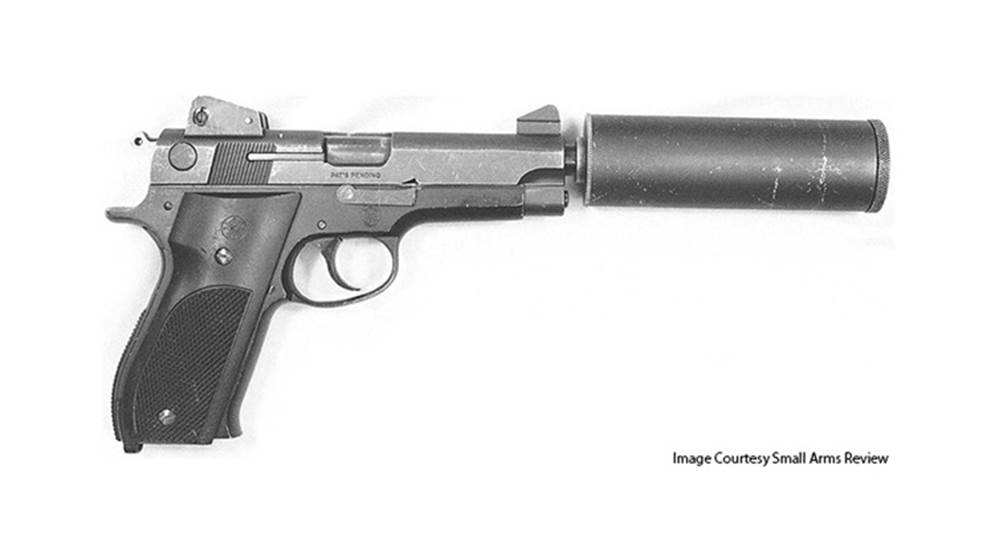
During the Vietnam war, the Sea, Air and Land special operators (SEALs) were just developing their covert techniques that would eventually make them into the finest fighting force in the world. Most of what these men did—the war stories and how they accomplished what they did—remains classified. Some facts eventually do leak out, and one of them was the existence of the “Hush Puppy” pistol, a modified Smith & Wesson Model 39 with a screw-on suppressor that was named the Mark 22 pistol by the U.S. Navy.
The SEALs were given the freedom to utilize non-standard military arms because of their special-operations status. At first, the Navy bought a handful of Model 39s for testing purposes. The fledgling SEALs got hold of them and found them useful. The Model 39 is a 28-oz. 9 mm double-/single-action semi-auto pistol with a 4” barrel and a single-column, 8-round magazine. At 11 ozs. less than the Model 1911A1, the compact 9 mm seemed to offer exactly what a covert operator needed in a sidearm. Its light weight and smaller profile were highly desired features by the early SEAL operators.
Then, as today, the guys in the field started pining for modifications to the standard Model 39. Relatively few were modified into Mark 22 status. Those modifications included a slightly longer barrel threaded at the muzzle to accept the suppressor, high-profile sights that could be seen and used with the suppressor, and a grip reconfigured to accept originally a Browning P35 double-column, 13-round magazine—later to accept a Smith & Wesson designed 14-rounder. A slide-lock switch was added to the frame to prevent the slide from operating, thus making the pistol a single shot. This was done to prevent the enemy from hearing the pistol operate. The suppressor was so effective with subsonic ammunition that the loudest part of the gun was the cycling of the slide. A detachable wire shoulder stock and holster were also part of the weapon package.
That suppressor, called the Mark 3, was 5” long and weighed 8 ozs. Because the frogmen often operated in a marine environment, a chamber plug and muzzle cap made from phenolic were included in the Mark 22 kit. Special ammunition, Mark 4, featured a 158-gr. FMJ bullet with a green tip and loaded to 900 fps. Also included as part of the kit was a spare suppressor insert tube with extra heavy rubber wipes. These wipes were reputed to be serviceable for a couple of dozen rounds or so before needing replacement.
If that seems rather fragile, remember this pistol was not intended as a quintessential self-defense weapon; rather it was designed around the need to take out sentries very quietly. SEALs were—and are—superb combat marksmen and were fully capable of neutralizing a target with a single round.
Altogether, the “Hush Puppy” Mark 22 package, including the pistol, can and a loaded 13-round magazine weighed in at 40 ounces, only an ounce heavier than a 1911A1 pistol. It was replaced in 1991 by the Mark 23 pistol, a 12-round-capacity .45 ACP made by Heckler & Koch. Though larger, heavier and more powerful than the first Mark 22 pistols, the concepts developed more than 50 years ago for a covert pistol for SEALs and other special operators still remain the foundation of such weaponry.
Very few—some say only two—original Mark 22 Hush Puppies have found their way into private collections. I was unable to find a “going rate” for such a collectable, but it would likely be astronomical.
The Model 39 Smith & Wesson remained cataloged for 27 years—1955 to 1982. Eventually Smith & Wesson made a commercial model of the Hush Puppy pistol, the 14-shot Model 59—sans the can, shoulder stock and extra-high sights. Later generations of these pistols were among the so-called “Wondernines” during the late 1980s and early ’90s.
Hush Puppy image courtesy Small Arms Review.